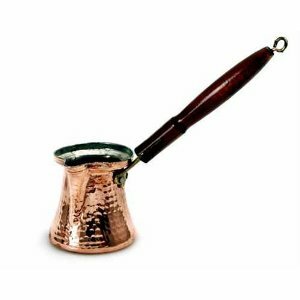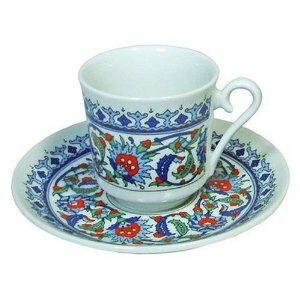How to Brew Turkish Coffee
[ad_1]
 Coffee brewed in the Turkish or Arabic style is one of my favourite ways of drinking my favourite drink. I love it equally in a good restaurant in Istanbul, with Romany friends in Bosnia, or with Bedouin friends in Israel, and this thick, sweet, aromatic brew tastes wonderful almost every time! The method of brewing has been used for at least 400 years, by all kinds of people groups, spreading from Eastern Europe to Western China. Despite its exotic associations, it is surprisingly easy to make, the equipment is cheap and readily available, and you can use almost any coffee that you like. It does mean boiling the coffee, which is normally one of the cardinal sins of coffee brewing, but the process itself is very quick, and the result in surprisingly non acidic.
Coffee brewed in the Turkish or Arabic style is one of my favourite ways of drinking my favourite drink. I love it equally in a good restaurant in Istanbul, with Romany friends in Bosnia, or with Bedouin friends in Israel, and this thick, sweet, aromatic brew tastes wonderful almost every time! The method of brewing has been used for at least 400 years, by all kinds of people groups, spreading from Eastern Europe to Western China. Despite its exotic associations, it is surprisingly easy to make, the equipment is cheap and readily available, and you can use almost any coffee that you like. It does mean boiling the coffee, which is normally one of the cardinal sins of coffee brewing, but the process itself is very quick, and the result in surprisingly non acidic.
What do you Need to Brew Turkish Coffee?
- You will need an ibrik or cezve (jezve), which is the name of the specialised Turkish Coffee Pot that you will use. It has a wide base and narrower neck, and is most often made of copper, with a wooden handle. If you travel to the Middle east, you can often get hand made pots in one of the local markets. You may want to get pots of several sizes, so that you can brew for friends when they visit. Avoid aluminum pots.
- Clean, filtered water. For a richer, creamier brew, you can use milk, or a mixture of milk and water.
 Very finely ground coffee. The grounds need to be the consistency of cocoa powder. You can use any coffee that you like, but the darker roasts often taste better. To get the best taste, it is better to get your self a brass Turkish Coffee Grinder, and brew with a fresh grind every time. When you have friends over, this is also part of the mystique!
Very finely ground coffee. The grounds need to be the consistency of cocoa powder. You can use any coffee that you like, but the darker roasts often taste better. To get the best taste, it is better to get your self a brass Turkish Coffee Grinder, and brew with a fresh grind every time. When you have friends over, this is also part of the mystique!- Additives – most people make the coffee with sugar in the brew, and you can add oriental spices for extra flavour
- A good heat source. An open flame, such as a gas or butane stove, is best, although you can do it on an electric stove as well.
Getting Started
- Start by placing one heaped teaspoon of ground coffee per cup of water into cold, fresh water (NOTE: the cup size is your standard espresso cup or demi-tasse). Make sure that you do not overfill the pot – you need plenty of space for the brew to froth up.
- Add sugar, typically one teaspoon per two teaspoons of coffee. You may substitute this with artificial sweetener if you prefer.
- You may wish to add some ground or crushed spice, such as cardamon (1/2 a teaspoon), or a spice mix of cardamon, cinnamon, nutmeg and cloves (1/4 teaspoon)
- Stir until the sugar is dissolved
Making the Brew
NOTE: You must keep your eye on the brew the whole time!
- Place the ibrik on the heat source, at a low heat. This will help bring the full flavour out.
- First boil – the coffee will suddenly come to the boil and froth up. This process is very quick, so keep your eye on the pot! Allow the coffee to froth up to the narrow neck, but do not let it boil over. Remove from the heat, and let the froth settle.
- Second boil – this time, the froth will come up even quicker, so be careful! At this point, you may wish to use a teaspoon to remove some of the froth and place a bit in each cup. Let the froth settle again.
- Third boil – again, very quick. You can serve the coffee after this boil (without stirring!), or for a super rich and creamy brew, give the pot a good stir to remove the grinds from the froth, and give the pot one more boil.
Serving the Coffee
 Use clean cups, and after serving, wipe any spills from the outside of the cup. It is considered bad manners to serve a cup that has spills on the outside.
Use clean cups, and after serving, wipe any spills from the outside of the cup. It is considered bad manners to serve a cup that has spills on the outside.- Pour small portions of coffee into each cup, returning to each cup until it is full. A bit of froth goes into each cup, but because of the ibriks’s narrow neck, most of the grounds stay behind. Each cup should have a little of the thick brown froth, or crema, on top. Some people prefer more of this crema, which is why you would spoon some into each cup for every successive brew.
- Allow the cups to settle for a minute or so, until all the sediment has sunk to the bottom
Sip the coffee until you taste the ‘mud’, but don’t drink the sediment. Enjoy the rich, thick flavour of coffee that is ‘as black as hell, as strong as death, and as sweet as love’!
